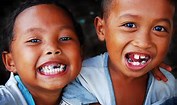





Children with 'prominent' forehead may in fact be suffering from a dangerous illness
Children with prominent, protruding foreheads and heavy brow ridges (otherwise known as frontal bossing) may be suffering from a serious illness first identified in 1645.
Rickets is a condition that affects bone development in children, sometimes leading to bone deformities. It is most commonly caused by prolonged vitamin D deficiency, as vitamin D helps the body absorb calcium from food.
Genetic defects can also play a role. Hypophosphatemic rickets, for example, is a genetic disorder where the kidneys and bones deal abnormally with phosphate such that there is too little in the blood and bones, leaving them weak and soft.
In addition to a pronounced forehead, swollen and painful wrists and ribs are another symptom of rickets. The mass-production of foods like margarine and cereal fortified with vitamin D meant that rickets all but disappeared in the western world during the early 20th century.
But malnutrition due to declining living standards is thought to have contributed toward an uptick in cases. According to the Big Issue, 10,986 people were diagnosed with malnutrition after being admitted to English hospitals last year, including 312 children - a number that has quadrupled in 15 years and doubled over the last decade.
And as the cost-of-living crisis shows little sign of abating, nutritious, Vitamin-D-rich produce is beyond the financial reach of many families. Changing cultural habits, such as spending more time indoors, may also be a factor.
Although any child who isn't getting enough vitamin D or calcium can develop rickets, the disease is more common among children of Asian, African-Caribbean and Middle Eastern descent as their skin typically has more of the pigment melanin, which reduces the skin's ability to produce vitamin D from sunlight.
Premature babies are also at greater risk as they may have not had the chance to build up sufficient stores of vitamin D while they were in the womb. A blood test is usually sufficient to confirm a diagnosis of rickets, though your child may also undergo X-rays or a bone density scan (DEXA scan), a type of X-ray that measures the calcium content in bones.
If left untreated, rickets can lead to:
-
Significantly stunted growth
-
An abnormally curved spine
-
Bone deformities
-
Dental defects
-
Seizures
Sources of vitamin D are:
-
Sunlight
-
Food, such as oily fish, eggs and fortified breakfast cereals
-
Dietary supplements
- Scientists have finally discovered the cause of morning sickness
- What young children need
- Breakthrough menopause drug that targets key symptom given approval for use in UK
- Keeping your children safe online: All you need to know
- Dear Exhausted and Burnt Out Parents, We’re Here to Help
- How to talk to your kids about death
- Use of menopausal hormone therapy beyond age 65 years and its effects on women's health outcomes by types, routes, and doses
- Scientists debunk myth that human brains are 'underdeveloped' at birth
- What are the health risks to children who vape?
- Changes to skin during menopause explained by experts, including dry skin and acne
- Acting Tips for Kids: How to Engage Your Child Through Theater
- How to nurture creativity in your kids
- Nine things you must consider before adopting a child
- An Overview of Psoriasis in Children
- DIY Fertility Tests Are On The Rise, But How Reliable Are They?
- Dentist shares when children should stop using dummies - or risk bite issues
- Top 10 benefits of breastfeeding
- Reye's syndrome: The illness that affects children
- Diphtheria symptoms: Everything you need to know after case confirmed at UK school
- Children with 'prominent' forehead may in fact be suffering from a dangerous illness
- Study assesses links between early negative life events, orbitofrontal cortical thickness and depression in young adults
- Placenta tumour: My miracle baby gave me cancer
- 7 things to look out for when it comes to vaginal health, according to gynaecologists
- What is the vaginal microbiome?
- What every woman should know about hormones, the pill and cancer
- Home
- Aches and Pains
- Children - Insomnia
- New Born Babies
- Babies From 2-12 months
- Spina Bifida
- Equipment Used
- Drug Abuse
- Other Ingredients
- The Handicapped Child
- Videos
- BALANITIS - Aromachildhood
- Worms
- Corona virus and pregnancy
- Contact Us
- Essential Oils for General Purposes
- The Methods - Aromatherapy - Children-2
- Hydrolats, Essential Oil Waters, and infused Oils
- Ringworm
- The Methods - Aromatherapy - Children- 3
- Basic Care Kit - Children - Essential Oils
- Web Links
- Acne
- Adolescent Acne
- The A - Z of Conditions
- Arthritis (juvenile Rheumatoid)
- Herbal Healing Infused Oils
- Things To Make For Your First Aid Cabinet
- The Cave Man Eating Plan
- The Basic Care Kit For Children
- Verrucas and Warts
- Caring Touch Massage
- The Methods - Aromatherapy - Children
- The Methods - Aromatherapy - Children - 4
- Athlete's Foot - 2
We have 89 guests and no members online






